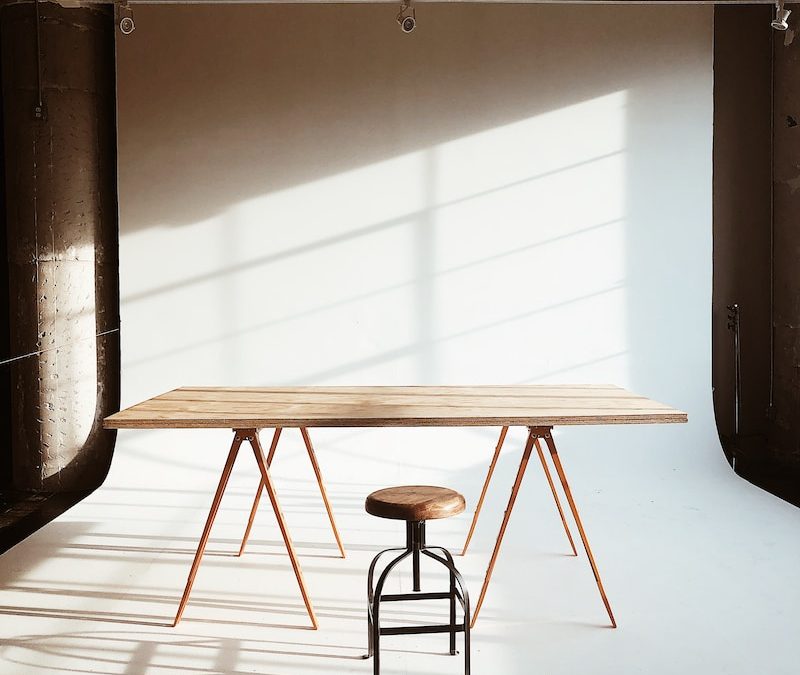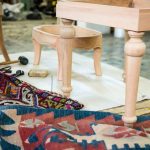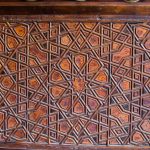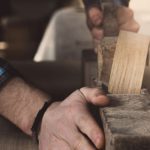Many homeowners face a challenge in finding a dining table that strikes a balance between style and functionality, as they seek the ideal piece for their needs. Live edge tables offer a unique way to bring your vision of modern elegance and rustic charm into reality. With my expertise in furniture design and interior styling, I recognize the challenge involved in selecting the appropriate materials for a unique and significant furniture item. This comprehensive guide on materials for live edge dining tables will equip you with all the necessary information to guarantee that you can achieve the desired style and quality without any compromise.
Live edge tables are all about freedom – they represent an expression of creativity and individuality that cannot be found in any other type of furniture. In case you’re after something sleek and contemporary or more traditional with hints of warmth and character, these pieces will allow you to create a look that feels uniquely yours. There’s nothing quite like sitting down around a stunning live edge dining table at dinner time; however, choosing from the huge range of available materials can be daunting if you don’t know where to start.
In this article, we’ll explore some of the different types of wood used in making live edge tables so that you can make certain your new purchase looks beautiful yet remains durable enough for everyday use. We’ll take a look at other materials often used alongside live edge wood and explain why careful consideration should be given when deciding which ones best suit your needs. From figuring out what kind of finish would work best with your chosen material to understanding its longevity – by the end of this guide, my aim is that you feel empowered to confidently select just the right combination for your own home.
Definition
Live edge is a term used to describe furniture pieces with an organic, flowing shape. It conveys the natural beauty of wood material and grain patterns that give it its unique character. Furniture pieces like this include dining tables, desks, nightstands, consoles, and more.
A dining table refers to any type of surface where people can gather together for meals or other activities. Common materials used in creating these surfaces are metal, glass, marble, and wood. A live edge dining table takes advantage of all the beauty that comes from using real wood as a base material.
The wood slabs material is composed of cellulose fibers arranged in various ways within the log slabs’s structure. These fibers form what we refer to as grain patterns which create unique designs on each piece of wood slab made of lumber harvested from trees. The process of sawing logs into plank slabs creates distinct shapes along the slabs at their edges known as ‘live’ wood slab edges due to their lack of straight lines or angles found in traditional furniture-making techniques.
Finish stain is applied over the top layer of wood after it’s been cut down into usable boards for building furniture or other project projects. This helps preserve the integrity and longevity of each piece by offering protection against spills and everyday wear-and-tear damage. Different colors and types can be chosen depending on one’s personal style preference – allowing them to customize their space however they, please!
When considering live edge furniture for your home or office, take note of how the definition applies to both its look and function; giving you a chance to enjoy unique designs while having practicality at hand too! With proper care and maintenance this timeless look will last generations so don’t wait – go ahead and get yourself some live edge today!
Types Of Wood
When choosing the perfect live edge wood for your countertops and your dining table, it’s fundamental to understand your options. From softwoods to hardwoods and lighter tones to darker shades, there is a wide selection of materials available that will add an exquisite touch of natural beauty to any home.
Soft Woods are often used for table and bar tops, as they provide lightness in color and texture with their grain patterns all around. Alder, Pine, Poplar, Spruce, and Cedar are just some examples of softer woods that lend themselves well to countertops, creating uniquely shaped tables with plenty of character. Each type has its distinct style that can be brought out further with treatments like oiling or staining if desired.
Hardwoods offer more durability than softwoods making them ideal for furniture pieces such as dining room tables. Mahogany, Oak, and Walnut are popular choices when deciding on a hardwood material but Maple, Cherry, and Teak also make great candidates due to their beautiful graining and range of colors. As these types of wood tend to last longer, they may require less maintenance over time compared to softer woods although both have advantages depending on what look you’re going for!
No matter which types of wood you choose for your live edge dining table top, each one offers something different in terms of characterful aesthetics and natural warmth – adding timeless charm wherever it stands! With so many different varieties available, you’re sure to find the perfect match for your space regardless of if you prefer light or dark hues; smooth grain lines or bold knots; raw texture, or glossy finish – only limited by your imagination!
Grains And Patterns
When it comes to living edge dining tables, the grain and pattern of the wood are just as dominant as its shape. The type of wood used for a table can have an impact on its overall aesthetics and durability. Different types of wood offer different levels of uniqueness in terms of grain patterns and textures.
Grain patterns refer to the lines that form due to growth rings within a tree or lumber. Each wood species also has unique characteristics when it comes to its grain patterns. For example, some woods are more open-grained than others meaning more visibility between individual grains while other woods may be tighter-grained with less visible space between them. On top of that, the orientation of each grain will affect how light reflects off of it creating either bright or dark spots depending on the angle at which they’re oriented. This contributes greatly to the character and beauty of a piece when looking at it from multiple angles.
The texture of the wood is something to evaluate when choosing your live edge table material as this will determine how smooth or rough you want it to feel against your fingers or skin. Wood texture refers not only to how coarse or fine it feels but to how easily it absorbs oils like waxes, polishes, stains, etc., enabling you to achieve a certain look without having too much effort involved in upkeep and maintenance over time. In case you prefer a smoother finish or something with more variation such as knots and other imperfections, there’s sure to be a wood out there perfect for your needs!
Choosing the right material for your live edge table involves understanding what makes each type special. Grain patterns and texture both play an integral role in determining which one works best for your next project so guarantee you understand all aspects before making any decisions!
Design Considerations
Designing with live edge wood slabs tables can be a thrilling experience. Every detail needs to be considered for the dining room layout and ergonomic seating to work together seamlessly. Color coordination, table shape, and live edge wood slabs profile all play a major role in creating an inviting atmosphere.
When it comes to color coordination, there are several options available depending on your style preference. Dark wood tones create a cozy but elegant effect while lighter colors lend themselves well to more airy spaces. The finish you choose contributes greatly to the overall look of the space; matte or glossy finishes will add a different feel than natural ones do.
Table shapes should take into account any nearby furniture as well as the size and layout of the room itself. Rectangular tables with rounded edges provide plenty of surface area without taking up too much floor space, while square-shaped end tables and bar tops typically offer a modern vibe that could fit nicely with contemporary decorating styles. When selecting the edge profile of coffee tables, think about how you want guests to interact around the table – thicker profiles may provide additional comfort during meal times whereas thinner profiles can make it easier for conversations to flow across the entire group easily.
No matter what design elements you decide on, always recall that live edge tables bring warmth and character into any home thanks to their unique beauty and organic lines. With careful consideration given to each element, you’re sure to find just the right combination that works best for your dining space!
Durability
When it comes to selecting the material for your live edge table dining, durability should be top of mind. The longevity factor of a piece will depend on its resistance to wear and tear over time. A good way to evaluate this is by looking at the product’s durability rating or conducting strength testing.
Furniture made of wood is a highly preferred choice due to its innate beauty and longevity that can span across generations if well-maintained. However, there are other options available such as metal or even plastic that may provide more durability than traditional woods if they’re given an appropriate finish coat. It’s vital to review factors like climate control when deciding between these alternatives since moisture and heat can affect their lifespan significantly.
No matter what type of material you choose, guarantee you perform regular maintenance inspections and tests on your live edge table dining regularly so that any potential issues can be identified early on before they become bigger problems down the line. Durability isn’t something that should be taken lightly. Having a piece designed with quality components gives you peace of mind knowing that it will withstand everyday use for years to come without needing too much upkeep or repairs along the way!
Cost Analysis
Let’s face it – choosing the right material for a live edge table dining experience is no small feat. When selecting furniture, numerous factors must be considered, including maintenance needs, appearance, and affordability. But don’t let that overwhelm you! Cost analysis doesn’t have to be daunting – think of it like balancing your checkbook; it may seem tedious at first but once you get the hang of it, you can take control of your finances with ease.
So, what should you know about pricing comparison when selecting materials for a project with a live edge table? First off, research different suppliers and compare their costs. It’s necessary to factor in shipping fees, taxes, and other additional charges when making your project budgeting decisions. On top of that, secure to look into any warranties or guarantees offered by each supplier before making your final project selection.
Lastly, weigh all options carefully and do an affordability study to determine which one fits within your desired price range while still meeting quality standards. A little bit of effort now could save a lot of time and headaches down the road! So go ahead: dive into the world of cost analysis and shop with confidence knowing that there is something out there suitable for every taste and pocketbook!
Finishes And Stains
Finishes and stains are a key part of the live edge table dining experience. The decision to protect your wood furniture with a finish or enhance its natural beauty with a stain can significantly impact the table’s appearance and texture in the long term.
When it comes to finishes and stains there are typically three main types: sealants, natural oils, and wood stains.
- Sealants: To shield the wood from environmental damage like moisture, dirt, and dust, a protective sealant is applied to its surface. This type of finish often be clear so as not to alter the color of the wood itself.
- Wood Stains: With various colors and shades available, wood stains offer a simple way to transform the appearance of your furniture without needing to refinish it. It is required to apply these stains uniformly across all surfaces to confirm a uniform look. Furthermore, depending on how light or dark you want them to appear against the underlying grain pattern will determine how many coats should be applied.
- Natural Oils: Natural oil finishes such as tung oil or linseed oil penetrate the grains of wood instead of just sitting on top like other finishes do; This gives them superior durability compared to conventional paints or waxes which may need more frequent reapplication due to wear over time. Natural oils bring out the natural characteristics in different species’ woods by accentuating their unique textures and patterns while providing extra protection from water damage.
No matter what type of finish you decide upon for your live edge table dining setup – if it be a sealant, wood stain, or natural oil – always think of that proper preparation before the application is key for achieving successful results!
Customization Options
Customization options for live edge tables are like a blank canvas, ready to be painted with the unique characteristics of your individualized style. By making a few customized adjustments and deliberate choices, you can craft coffee tables with a unique design that is both aesthetically pleasing and practical.
When making customization choices for your table dining experience, study the materials such as reclaimed wood, metals, or glass. Combining different textures and colors can help enhance the beauty of the natural grain in the wood and add an extra dimension to the look. From choosing intricate metal accents to adding delicate details on legs or feet, there are countless ways to customize your table so that it reflects your taste.
Live edge furniture lends itself well to creative upholstery possibilities – from removable cushions to fabric-covered chairs and beyond! Upholstered seating adds an unexpected element of comfort while still maintaining its rustic charm. By trying out various textiles, you can create unique color palettes and incorporate captivating designs, resulting in a distinctive atmosphere for your area.
Whatever customization option you choose, these small adjustments can have a big impact on how much character and personality your live edge table brings into your home. With careful consideration of material selections and tailor-made additions, you’ll soon find yourself at a beautifully customized dining table that was designed specifically for you!
Quality Assurance
When selecting the right material for a live edge table dining piece, quality assurance is paramount. To assure that you receive an exceptional product with long-lasting durability and beauty. Here are a few points to ponder:
- Wood Quality: Look for wood sourced from reputable mills or distributors who guarantee their products meet strict standards of quality.
- Manufacturing Process: It is vital to closely monitor every step to secure that it meets industry standards and sustainability guidelines. Ask suppliers questions about how they inspect, measure, package, and ship their materials.
- Wood Source: Carefully check where your supplier sources its wood from; sustainable forests are valuable for creating beautiful pieces without compromising on environmental ethics. Research companies that have high sustainability standards and certifications like FSC (Forest Stewardship Council).
- Quality Assurance Commitment: Lastly, seek out suppliers whose commitment to quality assurance goes beyond the normal expectations – look at customer reviews and ask them what procedures they follow to assure customers get exactly what they need!
Frequently Asked Questions
What Is The Average Cost Of A Live Edge Table?
The average cost of a custom live edge cutting board, or table can range widely depending on materials and size. As such, it’s helpful to think about what factors influence the price of each unique cutting board, or piece before making an informed decision.
The type of wood used plays an integral role in determining how much a live edge slab or table will cost. Hardwoods like maple or walnut tend to be more expensive than softer woods like pine or oak due to their durability and beauty. Further, if you opt for rarer species like bubinga or hickory, expect your live edge slab prices to climb even higher.
Besides the material and shipping costs, labor should be taken into consideration when budgeting for a live edge table. For example, handmade pieces usually require greater time investments from craftspeople and may come with additional fees as well. If you are looking for something truly special, bespoke designs crafted by artisans could be worth the extra expense!
When shopping for a live edge table, don’t forget to factor in all elements including wood quality, construction techniques, and labor costs so that you know exactly what kind of investment you’re making down the road.
How Do I Measure My Space To Ensure The Table Will Fit?
Did you know that the average live edge table costs between $1000 and $5000? When shopping for a new dining table, it is beneficial to verify that the size of your room and the size of your chosen table will work together harmoniously. Measurement plays a major role in determining if your live edge table fit comfortably in its intended space.
When measuring for a new dining table, start by taking measurements of both the room itself as well as any other furniture which may be present. Measure the length, width, and height so that you can accurately calculate how much space is available for your live edge table. It’s wise to review any potential obstacles such as radiators or doorways when calculating what size of a dining table would fit best.
Furthermore, to considering overall dimensions, think about how many people need to be seated at one time around the table. This number should determine how wide and long the live edge table needs to be—it must accommodate all guests comfortably without being too large for the space. If possible, it’s helpful to bring tape measures with you while shopping so that you can compare sizes on site before bringing home something that won’t fit properly into your desired area.
Choosing a furniture piece isn’t just about finding something beautiful—measuring correctly ensures that everything fits perfectly within its designated spot to create an atmosphere of comfort and relaxation rather than chaos and clutter. With some careful consideration up front, you’ll have no trouble selecting a stunning live edge dining table perfect for your home!
What Is The Difference Between A Live Edge Table And A Traditional Table?
Choosing the right table for your dining room can be a daunting task, but understanding the differences between a full live edge slab full-edge table and traditional tables is key to ensuring you are making an informed decision. A full live edge slab table adds an element of natural beauty to any space with its wood slab construction that showcases the organic curves of the tree it was sourced from. In contrast, traditional tables usually feature straight edges and uniform shapes. Here’s what else sets them apart:
- Live-edge Tables are one-of-a-kind pieces due to their unique features such as cracks, knots, or bark that cannot be replicated in mass production.
- Traditional Tables often have metal frames or legs which add stability and make them easier to assemble than live-edge designs.
- Wood Slab Construction makes a bold statement about sustainability and creating environmentally conscious furniture decisions when choosing a live edge design over a traditionally made piece.
- Table Style is something to ponder when selecting either type because both will bring very different aesthetics into your home; a live edge may look more rustic whereas a traditional style might give off more of an upscale vibe depending on the finish chosen.
As experts in furniture design, we believe these points should all be taken into consideration before deciding on which type would best suit your needs – if it’s interested in adding character to your interior through the use of nature inspired elements or infusing luxury vibes into your living space with timeless classic pieces. No matter which paths you choose, there’s always something special about having custom furniture that reflects who you are, and what better way to express yourself than by incorporating beautiful details like those offered by live edge tables!
How Long Does It Take To Build A Custom Live Edge Table?
Building a custom live edge table is a labor of love, and the result can be stunning. It offers an opportunity to create something unique that will become a centerpiece in your home for years to come. But how long does it take to build one? That depends on many factors but with careful planning, you can have your project for a beautiful custom-built table ready in no time.
The time required to build a custom live edge table varies depending on the size, design complexity, and materials used. Generally speaking, the larger or more intricate the design is, the longer it will take to complete. If you select high-quality hardwood lumber such as maple or oak along with quality hardware like steel fasteners and butcher block oil finish for protection, then this could add additional time due to the extra care needed during construction.
As an experienced furniture expert or furniture design specialist, I suggest taking into account all these variables when estimating the total amount of time needed for building your own custom live edge table so that you are not left disappointed at the end of your next project together. With proper planning and execution of other project, however, you should expect anywhere from three days up to several weeks if working full-time on your new masterpiece – depending on its size and complexity. And while there may be some unexpected challenges along the way, once the project is done right it’s sure to bring joy, pride and freedom into your life!
Are There Any Special Care Instructions For A Live Edge Table?
Are you wondering what type of special care instructions are needed for a live edge table? Knowing the right way to treat your custom-made live edge table will prevent damage and keep it looking its best. As an expert in furniture design, I’m here to provide you with some key tips on taking proper care of your live edge table:
- Clean gently using soap and water – avoid any harsh chemicals or abrasive cleaners that might strip away the natural finish.
- Make sure spills are wiped up quickly, as standing liquids can cause staining or warping of the wood.
- Dust regularly with a lint-free cloth to remove dust particles from the surface.
- Avoid direct exposure to sunlight, which can fade and discolor the wood over time.
- Apply oil periodically (once every few months) to help protect against wear and tear.
Taking good care of your live edge table is needed if you want it to last a lifetime! If done properly, careful cleaning is all that’s required to maintain the beauty of this unique piece of furniture. Just think of – never try and force anything onto the surface; instead, take extra precaution by lightly wiping down with a damp cloth before applying oils or polishes.
With these simple steps, your live edge table should stay in great condition for many years without requiring extensive treatment or repairs!
There is a wide range of material options to choose from when deciding on the appropriate materials for a live edge table. It’s significant to think about your budget and space when making this decision. A custom-made table made from high-quality materials can last generations but may come with a higher price tag.
Figuring out how large of a table you need is the key – if you select one that’s too big or small for your dining area it could be an eyesore. Live edge tables have beautiful organic lines that traditional styles don’t offer, so they require extra care to preserve their natural beauty over time.
Lastly, building a custom live edge table requires careful consideration of cost, size, and maintenance. If the job is done correctly, however, it becomes the centerpiece of any room or house, and provides years of joy for family dinners and special occasions alike.







